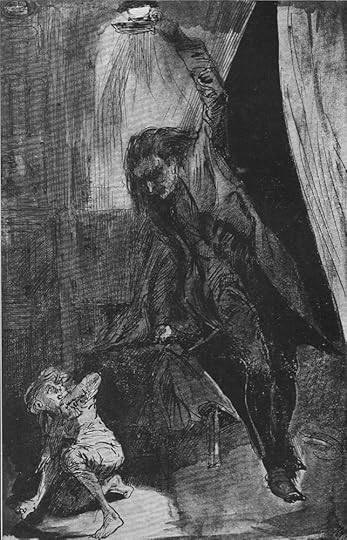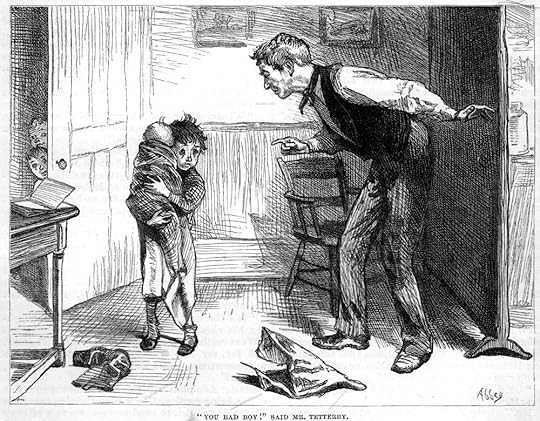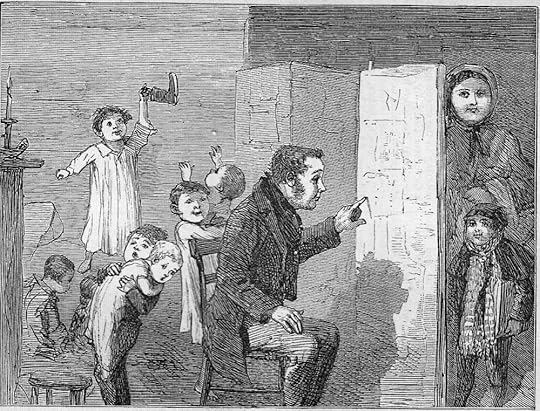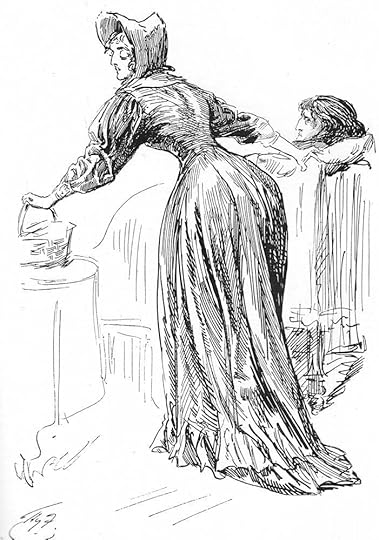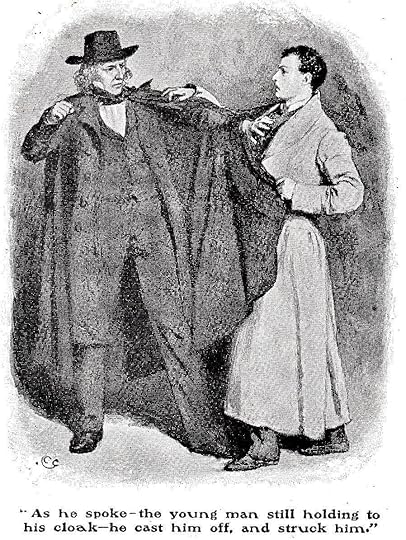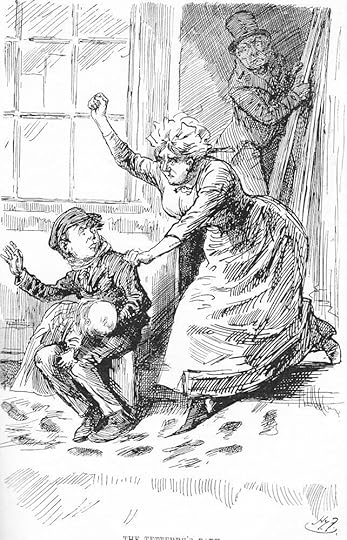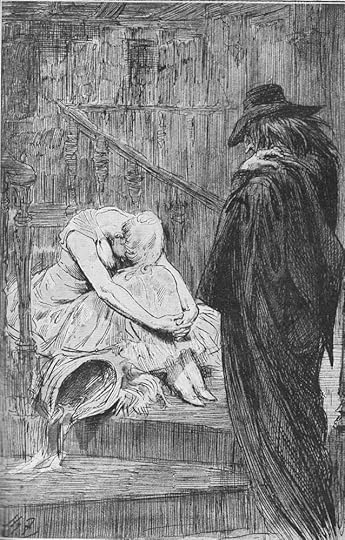Dickensians! discussion

This topic is about
The Haunted Man and the Ghost's Bargain
Novellas and Collaborative Works
>
The Haunted Man and the Ghost's Bargain (hosted by Petra)
date newest »
newest »
 newest »
newest »
message 451:
by
Petra
(new)
-
rated it 4 stars
Jan 22, 2025 07:57PM
 I'm Eighty Seven by A.E. Abbey, 1876
I'm Eighty Seven by A.E. Abbey, 1876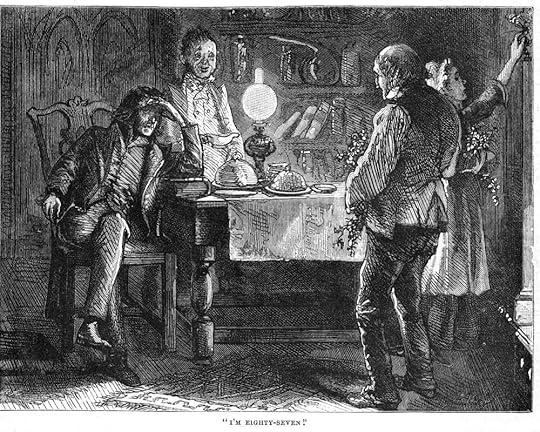
reply
|
flag
 .....and now a couple of Political Illustrations made by using illustrations from The Haunted Man and the Ghost's Bargain:
.....and now a couple of Political Illustrations made by using illustrations from The Haunted Man and the Ghost's Bargain:A Scene from The Haunted Man by John Leech, 1849
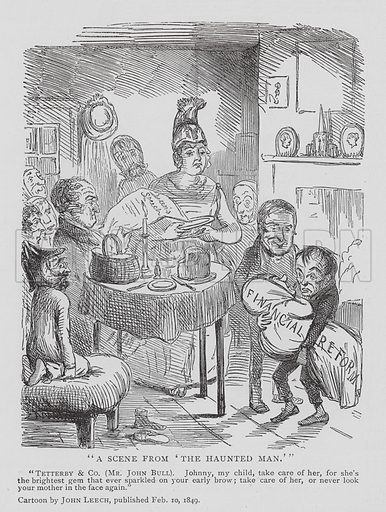
 The Haunted Man by John Gordon Thomson, 1893
The Haunted Man by John Gordon Thomson, 1893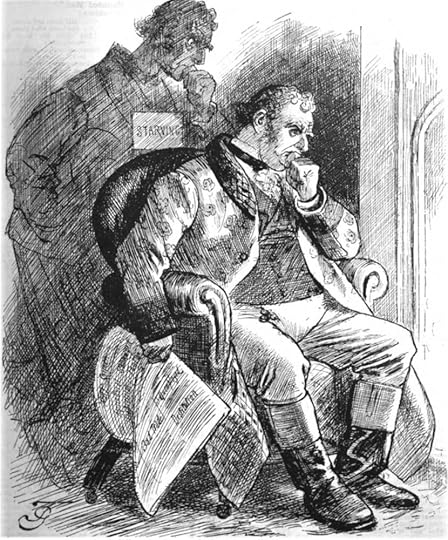
The verses that accompany this editorial cartoon proclaim that although “John Bull sits snugly by his fire” while “fiercely without may winter roar,” he finds himself haunted by “his other self, a phantom lean.”
"Hunger seems written on his face,
Where misery’s pangs have left their trace — . . .
Ah, but that phantom never flies
’Tis ever at hand in woeful guise —
He is a haunted man! "
Since , in Dickens’s The Haunted Man and the Ghost's Bargain a “terrible secret from the past . . . blights the present,” it is possible that the cartoonist intends to remind us not only of present “starving folk” but also of the horrific Irish famine of the 1840s.
The cartoonist assumes that readers of Fun will immediately make the connection between the 1848 novella and social conditions in England, personified as a less-than-jolly, highly ruminative John Bull.
- from The Victorian Web:
https://victorianweb.org/periodicals/...
 John Bull is a national personification of the United Kingdom, especially in political cartoons and similar graphic works.
John Bull is a national personification of the United Kingdom, especially in political cartoons and similar graphic works. He is usually depicted as a stout, middle-aged, country-dwelling, jolly and matter-of-fact man.
He originated in satirical works of the early 18th century and would come to stand for English liberty in opposition to revolutionaries.
He was popular through the 18th and 19th centuries until the time of the First World War, when he generally stopped being seen as representative of the "common man".
 Fun magazine was a Victorian weekly humorous magazine, first published on 21 September 1861 in competition with Punch.
Fun magazine was a Victorian weekly humorous magazine, first published on 21 September 1861 in competition with Punch.At a penny an issue Fun undercut its rival, Punch, and prospered into the 1870s, after which it suffered a gradual decline. It passed through various ownerships under different editors, and ceased publication in 1901, when it was absorbed into a rival comic magazine, Sketchy Bits.
Fun Magazine Issues 1861-1901
https://archive.org/details/pub_fun?s...
Sketchy Bits Volume 3 No 148 Cover, 1898:
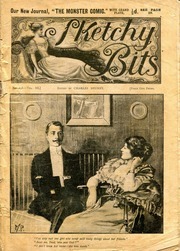
 I love the way Sam and Peter summarized Dickens point about memories and loss. What Peter said, that loss is what makes us most human, seems so true to me. And since we always look to someone who understands for comfort, it helps us help others too. Very human.
I love the way Sam and Peter summarized Dickens point about memories and loss. What Peter said, that loss is what makes us most human, seems so true to me. And since we always look to someone who understands for comfort, it helps us help others too. Very human.I just love this Gallery of Missed Illustrations, Petra! The first three are my favorites. The one of Milly by Harry Furniss made me think, "she looks like a Gibson Girl!" Definitely not how I pictured Milly, but I realized the Gibson Girl was created in 1898, so not long before this illustration in 1911.
 Oh, and it looks like the political cartoons handled allegory for us. :-) What a treat, Petra. Thank you!
Oh, and it looks like the political cartoons handled allegory for us. :-) What a treat, Petra. Thank you!
 I love all the images of the ghostly doppleganger; it's such a powerful image in both the story and in art for a man haunted by himself, someone whose thoughts have become their own enemy.
I love all the images of the ghostly doppleganger; it's such a powerful image in both the story and in art for a man haunted by himself, someone whose thoughts have become their own enemy.
 A thank you from me, as well, Petra, for the additional illustrations. I love that Dickens was so universally read and understood that political cartoonists could use him with confidence that most, if not all, the people would recognize the allusion.
A thank you from me, as well, Petra, for the additional illustrations. I love that Dickens was so universally read and understood that political cartoonists could use him with confidence that most, if not all, the people would recognize the allusion. The dopplegangers are also a favorite for me, Greg. We are so often haunted by, and held back by, our own thoughts. The things we say to ourselves can be very powerful.
 I loved this story and a big thank you to Petra for leading us through it, adding wonderful illustrations and historical & cultural context of the times. And I so enjoy all the discussions as well.
I loved this story and a big thank you to Petra for leading us through it, adding wonderful illustrations and historical & cultural context of the times. And I so enjoy all the discussions as well.Today I must set reading aside & dig my car out of the snow to get to appts and errands.
 Thank you so much Petra, for leading this wonderful read! You always do such an amazing job! I had so much fun reading with everyone. I really loved the message of this story. Reading with everyone helped me sort through the confusing parts, so I could just enjoy the overall feeling.
Thank you so much Petra, for leading this wonderful read! You always do such an amazing job! I had so much fun reading with everyone. I really loved the message of this story. Reading with everyone helped me sort through the confusing parts, so I could just enjoy the overall feeling.I truly loved the way Dickens wrote about Milly's loss of her unborn child. I wondered how he could write with such truth about that kind of pain. I knew he and Catherine lost their daughter Dora in 1850 when she was very young (8mos old). But when I looked it up, I realized he wrote this story in 1848 - so he hadn't experienced that pain yet - and still he wrote beautifully and truthfully. It touched my heart.
Thank you also, Petra for the extra illustrations. My favorite is from comment 460 "Spring Killed By Haggard Winter by Harry Furniss, 1910". I was so glad someone illustrated the poor, abused woman on the steps. It's a small moment in the story, but an important one, I think. We've seen fallen women in his novels, but not in his Christmas stories (unless I'm remembering wrong). Between her and the "wild boy" this story very much champions the plight of society's most vulnerable. It's very moving. I can see why the story led to political cartoons.
message 471:
by
Bionic Jean, "Dickens Duchess"
(last edited Jan 23, 2025 12:21PM)
(new)
-
rated it 4 stars
Bridget wrote: " I was so glad someone illustrated the poor, abused woman on the steps. It's a small moment in the story, but an important one, I think. We've seen fallen women in his novels ..."
This reminded me of an earlier read a few months ago of No Thoroughfare, led by Lee (who I understand has been reading along too 😊)
All along I have felt that Charles Dickens's belief in the divided self is strong in this story. Sam I think this links up with your thoughts on the psychological component.
Charles Dickens has just given it an extra twist, as Sara and Shirley have identified, by emphasising the supernatural component, and thereby - rather oddly - making it easier for us to accept the idea in a story.
This reminded me of an earlier read a few months ago of No Thoroughfare, led by Lee (who I understand has been reading along too 😊)
All along I have felt that Charles Dickens's belief in the divided self is strong in this story. Sam I think this links up with your thoughts on the psychological component.
Charles Dickens has just given it an extra twist, as Sara and Shirley have identified, by emphasising the supernatural component, and thereby - rather oddly - making it easier for us to accept the idea in a story.
 Bionic Jean wrote: "All along I have felt that Charles Dickens's belief in the divided self is strong in this story. Sam I think this links up with your thoughts on the psychological component..."
Bionic Jean wrote: "All along I have felt that Charles Dickens's belief in the divided self is strong in this story. Sam I think this links up with your thoughts on the psychological component..."Actually, you opened a new dimension to the story which I hadn't given much consideration, being so occupied with my own thoughts.
I love how we find more and more depth as we share our thoughts.
I was trying to say in seventy-five sentences what Peter said in about five-- that Dickens was trying to explain compassion and giving, asserting our individual memories of pain allow us to best indifference an enable us to act in the benefit of others. But I fell the key in the allegory is to not forget our suffering lest we are unable to feel for others which leads toward the monstrous behaviors of Redlaw which then was picked up by the others. In my mind, this story is not just a reminder to be charitable to those we know (like Christmas Carol), but is a call to act on behalf of those we don't know or may not even like. So I see this as a call to action perhaps in response Dickens saw in the poverty around him.
I do like that Doppelganger thought as well!
 Bridget wrote: "I truly loved the way Dickens wrote about Milly's loss of her unborn child. I wondered how he could write with such truth about that kind of pain. I knew he and Catherine lost their daughter Dora in 1850 when she was very young (8mos old). But when I looked it up, I realized he wrote this story in 1848 - so he hadn't experienced that pain yet - and still he wrote beautifully and truthfully. It touched my heart.
Bridget wrote: "I truly loved the way Dickens wrote about Milly's loss of her unborn child. I wondered how he could write with such truth about that kind of pain. I knew he and Catherine lost their daughter Dora in 1850 when she was very young (8mos old). But when I looked it up, I realized he wrote this story in 1848 - so he hadn't experienced that pain yet - and still he wrote beautifully and truthfully. It touched my heart...."
Bridget, that plot twist caught me by surprise. It was such a heartbreaking developement.....and, yet, explained Milly's kind goodness so well. She took her grief and made it something good, while cherishing the short time she had with her child.
It made me extra glad that she found the boy. They need each other.
 Thank you for joining me in this read. I look forward to our time together each year.
Thank you for joining me in this read. I look forward to our time together each year.See you all next Christmas!
 .....I'll be hanging around here all year......that last statement sounded like I wouldn't be. LOL...
.....I'll be hanging around here all year......that last statement sounded like I wouldn't be. LOL...
 Petra, I can't thank you enough for all the work you put into this read, and making it such a pleasure for all of us! I'm already looking forward to next Christmas! :-)
Petra, I can't thank you enough for all the work you put into this read, and making it such a pleasure for all of us! I'm already looking forward to next Christmas! :-)
 Petra! Thank you so much for all these wonderful illustrations! It is amazing how many artists chose to illustrate this novella. Per page, this would have to be the most illustrated Dickens work? One of my favorites was also "Spring Killed by Haggard Winter". I couldn't figure out where this fit into the story, so I'm so glad that Bridget said "I was so glad someone illustrated the poor, abused woman on the steps. It's a small moment in the story, but an important one, I think." Furniss really did capture the sorrow and despair of this poor abused and neglected creature. This illustration really touched my heart.
Petra! Thank you so much for all these wonderful illustrations! It is amazing how many artists chose to illustrate this novella. Per page, this would have to be the most illustrated Dickens work? One of my favorites was also "Spring Killed by Haggard Winter". I couldn't figure out where this fit into the story, so I'm so glad that Bridget said "I was so glad someone illustrated the poor, abused woman on the steps. It's a small moment in the story, but an important one, I think." Furniss really did capture the sorrow and despair of this poor abused and neglected creature. This illustration really touched my heart.It's such a testament to Dickens' popularity that political cartoonists chose scenes from The Haunted Man to make political points - knowing people would be able to identify the references. That's pretty amazing for a novella!
This was such a great story! And I love Dickens' final sentiment "Lord, keep my Memory green." That is such a poignant wish that I think we can all relate to.
Thank you, Petra; thank you, Jean; and thank you, fellow Dickensians! for a wonderful reading experience!
 You're welcome, everyone. I had as much fun as anyone with this read. It's wonderful to spend time with you all and read such a good story.
You're welcome, everyone. I had as much fun as anyone with this read. It's wonderful to spend time with you all and read such a good story.
You raise the bar every time Petra! Thank you 😊
And may I just mention here that John is raring to go with his read of American Notes For General Circulation, and has posted several comments already. Please get your copy now, if you haven't got one and join the thread LINK HERE
I'll leave this thread current for a few more days before it is placed in the "Novellas" section, and then it will remain open as a valuable resource, and for further comments.
Thanks everyone!
And may I just mention here that John is raring to go with his read of American Notes For General Circulation, and has posted several comments already. Please get your copy now, if you haven't got one and join the thread LINK HERE
I'll leave this thread current for a few more days before it is placed in the "Novellas" section, and then it will remain open as a valuable resource, and for further comments.
Thanks everyone!
Books mentioned in this topic
American Notes for General Circulation (other topics)No Thoroughfare (other topics)
The Haunted Man and the Ghost's Bargain (other topics)
The Haunted Man and the Ghost's Bargain (other topics)
The Cricket on the Hearth (other topics)
More...
Authors mentioned in this topic
Charles Dickens (other topics)Michael Kitchen (other topics)
Alan Bleasdale (other topics)
Fred Barnard (other topics)
Sol Eytinge Jr (other topics)
More...

